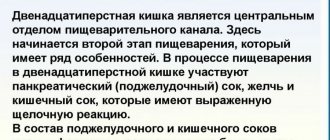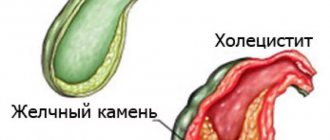| Nutrition and diet for stomach and duodenal ulcers is a condition without which it is impossible to imagine successful treatment of peptic ulcer. This therapeutic diet corresponds to the “Table No. 4” diet. This article tells you about what foods you can eat on this diet (Table No. 1) for stomach and duodenal ulcers and what you can’t, as well as about sanatoriums where ulcer sufferers can improve their health. I am a mother. My first and only child has an intolerance to cow's milk protein, and all sorts of gases. I don’t know what you can eat and what it’s better not to put in your mouth. A more experienced friend gives me some advice. “I didn’t eat this, I evaporated this, I soaked this.” In short, you need dietary table number 4. – What-what table??!! *** My mother-in-law takes out an old home book from the nth year, “Recipes for Diet Tables.” I look at her and understand that since I lived to be 35 and haven’t heard a thing about these very tables, everything is fine with my digestion. There are more than a dozen of these tables. |
People suffering from various gastrointestinal diseases know about slimy porridges, pureed curds, and the third broth. This is especially true for ulcer patients.
My interlocutor, Deputy Chief Physician for Clinical Expertise at Krasnoyarsk Interdistrict Clinic No. 1 Anna Andreevna Eremeeva, never tires of repeating:
– Treatment of ulcers is medicinal, yes! But first of all it is a diet. It is important not only in prevention, but also in treatment. I won’t even talk now about the fact that we exclude sour and salty foods. It's obvious. The most important thing here is that a person’s stomach does not remain hungry. Those. meals should not be as we are used to. In the morning I had breakfast, I don’t know how, and drank coffee. At lunchtime I intercepted something along the way. And I already ate a lot for dinner. This is the wrong diet. There should be several meals, 4-5. In the morning you need to have breakfast. It's good to start the day with porridge. Preferably mucous membrane that envelops.
Principles of nutrition for duodenal ulcers
- Under no circumstances should you go hungry. You should eat 5-6 times a day in small portions.
- Dishes are steamed or boiled; they can be eaten pureed or unmashed.
- Baking is possible, but only after preliminary boiling.
- You should eat food at the same time every day. Thanks to a stable daily routine, the body prepares for food intake, and it is better absorbed.
- Eat food slowly and without distraction.
- You will have to limit the amount of salt (up to 6 g per day) and monitor the amount of water you drink. An adult needs 1.5-2 liters of clean water per day.
- Do not irritate the walls of the stomach and intestines with too hot and cold foods.
- The temperature of the food should not exceed 60 degrees and be below 15 degrees.
On a note
Rich broths, baked goods and baked goods, smoked meats, sharp cheese, canned food, snacks (chips, crackers), fast food, alcoholic and carbonated drinks are completely excluded from the diet for duodenal ulcers.
It is undesirable to consume fried, salty, spicy foods, herbs and spices.
Products containing coarse plant fiber are prohibited. These are white and red cabbage, spinach, black bread, turnips, radishes, sorrel, mushrooms, legumes, millet.
Diet No. 1
Follow table 1. Diet No. 1 is the recommended standard for patients with peptic ulcer disease. During the period of exacerbation, for ten to fifteen days, adhere to “table 1a”, which involves eating foods in liquid or jelly form.
In the future, it is recommended to switch to “table 1b”, which corresponds to pureed and mushy food. During the period of stable remission, one should be guided by the rules of the standard “diet 1”, which provides for the loose consistency of products, their consumption in grated or well-chopped form.
List of foods and dishes that are included in the diet for duodenal ulcers
- Puree semolina, rice, oatmeal, buckwheat milk porridge.
- Steam or baked omelette.
- Non-acidic cottage cheese, milk, sour cream (in dishes, for example, soups).
- White bread, freshly baked (no more than 300 g per day) or dried biscuits.
- Cereal, slimy soups, puree soups, soups with pasta.
- Quelles or soufflé made from beef, veal, chicken, rabbit, turkey, lean fish.
- Potatoes, zucchini, pumpkin, cauliflower, broccoli, carrots, beets in the form of puddings and purees.
- Kissels, smoothies, fruit jelly, sweet berries.
- Tea diluted with milk, rosehip decoction, milk jelly, chicory coffee drink with milk, non-acidic compotes.
Myths about nutrition for ulcer patients
Finally, let’s dispel a few myths about the nutrition of ulcer patients.
Actually, there is only one myth: You will have to eat tasteless pureed food! Nutritionists have already reconsidered their previous strictness and do not insist that patients bring all their dishes to the state of liquid puree. The main thing is to adhere to general principles and find a positive aspect in such nutrition.
It would seem that a diet with boiled and steamed products is a green melancholy, but if you look at things philosophically, then where else can you find puddings and quenelles, soufflés and pates, mousses, meringues and cream soups. At least you can have a real feast at home. Well, if you take care of yourself more closely, then the time of culinary retreat can be reduced.
Completeness of the diet
On a note
When prescribing a diet, it is extremely important to take into account the nature and stage of the disease, the condition of other organs and systems.
If the diet is used for a long time, it is necessary to take care of the completeness of the diet. And with this, “Diso®” “Nutrimune” will provide invaluable assistance, which compensates for the protein component of the diet without overloading the gastrointestinal tract.
"Diso®" "Nutrimune" helps to compensate for protein deficiency in dietary nutrition and does not put additional stress on the digestive system.
The product is odorless and does not affect the usual taste and consistency of dishes. It can be added to soups, porridges, jelly and other dishes at any stage of preparation.
Causes
The most common cause of peptic ulcer disease is infection with the bacterium Helicobacter pilory. It can be contracted through saliva through close contact with another person. In patients with duodenal ulcers, helicobacter is detected in 90% of cases; in patients with gastric ulcers, the figure is 50–60%.
In addition to bacteria, stress, poor diet and long-term use of non-steroidal drugs can be a provoking factor. Many people believe that a peptic ulcer is a complication of gastritis, but this is not true: these are different diseases and gastritis does not develop into a peptic ulcer.
Diet after surgery
The standard recommendation is to fast for up to two days for the initial healing of the sutures. In the future, the following requirements are adhered to.
- On day 3. The patient can eat in accordance with the 0a diet, provided that he does not have bloating. Meals are split, up to seven times a day. The consistency of the dishes is exclusively liquid or in the form of jelly. The first meal should be the smallest, in the amount of one teaspoon. In this quantity, the patient is offered hourly juices diluted with water, fruit jelly, and weak meat broth. Over the course of two days, the volume of a single serving is increased and the patient is transferred to six to seven meals a day.
- On day 6. Gradual expansion of the diet and bringing it to the standard diet of table No. 1 by introducing pureed porridges, slimy soups, soft-boiled eggs or in the form of a steam omelet.
The diet should contain the maximum amount of protein components and vitamins, while carbohydrates, especially simple ones, should be kept to a minimum. This will allow you to saturate the diet with the spectrum of nutrients necessary for the patient in a small portion size.
General rules
Peptic ulcer disease is a chronic disease, the manifestation of which is a recurrent ulcer. Peptic ulcer of the stomach and duodenum occurs against the background of an imbalance between aggressive factors, which are Helicobacter pylori and the acid-peptic state, and protective factors - the mucus of the duodenum and stomach and the ability of the mucous membrane to repair. Today we will touch on duodenal ulcer and nutritional characteristics during different periods of the disease.
In the typical version, the ulcer is localized on the posterior or anterior wall of the duodenum and more often in the bulb (this is the part of the duodenum closest to the stomach). Functionally, this part is associated with the intake of acidic gastric contents, which here acquire an alkaline reaction. The duodenal glands produce an alkalizing secretion, and normally stomach acid is neutralized. The alkalization process is also affected by bile and pancreatic juice (the bile duct and pancreatic juice open into the bulb).
The causes of duodenal ulcer are:
- infectious pathogen Helicobacter pylori, which is detected in 70-80% of patients;
- eating disorders (consumption of fried and fatty foods, fast food, starvation diets, consumption of alcohol and excessively spicy foods);
- long-term stressful situations, which in the case of an ulcer of the bulb cause disruption of the nervous regulation of its function (the secretion of protective mucus is disrupted).
For these reasons, the secretory function of the duodenum is disrupted and its protective barrier is reduced, constant irritation of the mucous membrane is maintained, ultimately leading to an ulcerative defect.
The main complaint with this disease is pain. Its intensity depends on the state of the nervous system, age and individual sensitivity of the patient to pain. The pain takes on a nocturnal and “hungry” character and is significantly reduced when eating. A characteristic rhythm of pain is noted: hunger-pain-eating-pain-free interval-hunger-pain again.
Dyspeptic disorders are also typical - heartburn , vomiting, nausea and belching. As the duration of the disease increases, the number of these symptoms increases. Some patients may have a decreased appetite and often experience a tendency to constipation or diarrhea .
Treatment is aimed at eliminating aggression factors and includes:
- suppression of gastric secretion;
- anti-Helicobacter therapy;
- correction of the patient’s psychoneurological status;
- stimulation of reparative processes in the mucosa.
In order to suppress secretion, H2 blockers ( cimetidine , ranitidine , famotidine ), which have recently been used less and less because they do not completely block acid synthesis. They were replaced by proton pump blockers, which are 3-10 times H2 blockers The era of PPIs began with Omeprazole , later this group was replenished with Lanzoprazole , Pantoprazole , Pariet ( rabeprazole ) and Esomeprazole .
Effective regimens have been developed for anti-Helicobacter therapy - 3-component and 4-component, prescribed for 7 days. Due to the risk of developing dysbiotic changes in the intestines, probiotics ( Bifiform , Linex ) are included in parallel.
Normalization of autonomic tone is achieved by taking Atarax , Adaptol or Grandaxin . As a result, autonomic reactivity is restored, which ensures an adequate response of the body to external stimuli. Due to the restoration of psycho-vegetative balance, an acceleration of scarring of ulcers is noted.
Among the agents that enhance reparative processes, one can name Gastritol , which includes plant components that promote the rapid restoration of damage to the mucous membrane. Next, the issue of maintenance therapy is resolved. For multiple ulcers, continue taking De-nol and PPIs for up to three weeks. With concomitant gastroesophageal reflux disease, the duration of taking antisecretory drugs is increased to 6-8 weeks.
Violation of the diet and consumption of food that irritates the mucous membrane is one of the causes of peptic ulcer disease, therefore therapeutic nutrition is an important component of treatment. The diet for duodenal ulcers is aimed at eliminating pain and dyspeptic symptoms. Therapeutic nutrition for peptic ulcers should help reduce the acid factor, the activity of which is most often increased, and stimulate ulcer healing.
At any stage of the disease, secretion stimulants and mucosal irritants are excluded (to one degree or another). Eating small portions of food is gentle on the mucous membrane and reduces inflammation of the duodenum. Regular and small meals greatly facilitate the digestion and absorption of foods.
During different periods of the disease (exacerbation, unstable remission, stable remission), the diet is different and the following tables can be prescribed sequentially:
- No. 1A with maximum limitation of all types of effects on the mucous membrane;
- No. 1B with a mild limitation of all types of aggression on the stomach, the average treatment time is up to two weeks;
- №1 with moderate sparing of the stomach.
The timing of these diets depends on the patient’s condition and the severity of pain and dyspeptic syndrome. The sequential assignment of tables with a gradual expansion of products and different methods of preparing them prepares the gastrointestinal tract for the transition to a common table.
What diet is used during exacerbation of the disease? It depends on the severity of the exacerbation. For severe pain, Diet 1A , which maximally limits all factors of influence (mechanical, chemical and thermal). The diet includes warm, pureed dishes, the consistency of which is liquid, but as the process subsides, it becomes mushy. Products that have a weak juice effect are consumed (milk, eggs, pureed cereals with milk, boiled fish and meat in various forms of preparation). This dietary food is prescribed for the period of severe exacerbation - 7-10 days.
- It is recommended to eat six meals a day with limited portion sizes.
- Food is prepared in liquid or jelly form, which spares the mucous membrane as much as possible and promotes ulcer repair.
- Only slimy soups (with water or milk), prepared from oatmeal, semolina or rice. Mucus soups are decoctions obtained by cooking cereals, which are filtered and the cereals are removed. You can add a little salt to the finished soup and add butter to it. This type of soup can be prepared from ground cereal flour.
- Meat, chicken and fish dishes in the form of puree or steam soufflé. For cooking, choose lean varieties of meat and fish, peeled from skin and tendons and passed through a meat grinder several times.
- Porridge made from buckwheat, rice and oatmeal. They are well boiled, rubbed and diluted to a liquid state with water (milk). A small amount of butter is added to the finished porridge.
- Milk, calcined cottage cheese, milk jelly and cream (in soups). Whole milk - 4 glasses per day.
- Soft-boiled eggs or steam omelet. The patient can eat 2 eggs daily.
- Kissels and jellies from sweet berries, berry and fruit juices, diluted with boiled water with the addition of sugar or honey. You can drink weak tea (with milk, cream), rosehip infusions and a decoction of wheat bran.
Table No. 1A provides for the exclusion of secretion agents and mucosal irritants from the diet: any broths, sour drinks and juices, fermented milk drinks, any vegetables, coarse cereals and bread.
Food should be light and easily digestible, so mushrooms, tough meat with tendons, poultry and fish skin are not allowed. Eating excessively cold and hot foods is not allowed. Because sharp food temperatures have an adverse effect on the mucous membrane and slow down the regeneration processes of the mucous membrane.
After a week, as the condition improves, the patient can be transferred to Table No. 1B . This table is less restrictive and gradually increases the content of nutrients and calories. The cooking methods and the main list of products remain the same, but dried wheat bread, vegetable and fruit purees are added (can be used for baby food). Instead of slimy soups, pureed soups are used, and meat and fish can be used to make quenelles, purees and cutlets.
During the recovery period after an exacerbation, as well as during mild exacerbation, patients are prescribed moderately gentle and physiologically nutritious nutrition - Table No. 1 . Previously, there were recommendations for a patient to remain on this therapeutic diet for a long time (up to six months). However, if you feel well, the time spent on Diet No. 1 is reduced to 2-3 months.
The absence of strong irritants in food (meat, mushroom broth, fish soup, strong tea, fried foods, coffee, carbonated drinks, marinades, mustard, alcohol) creates conditions for successful treatment and a long relapse-free period.
The diet is expanded by not pureed food and raw vegetables and fruits are added (sweet plums, apples, apricots, peaches, nectarines, and tomatoes). When carrying out anti-relapse treatment in the autumn-spring periods, you should again switch to gentle nutrition for 2-4 weeks (first Table No. 1B , and then No. 1 ).
A perforated ulcer (the formation of a through defect in the wall of the duodenum) is one of the most dangerous complications, since the contents of the intestine enter the abdominal cavity and cause peritonitis . This condition is considered urgent and surgical intervention is indicated. In most cases, the perforated ulcer is sutured.
After surgery for a perforated ulcer, the diet is very gentle; dishes are steamed without oil or salt. Dishes high in carbohydrates are kept to a minimum, liquid intake and portion sizes are limited.
- the first two or three days - hunger;
- from the fourth day, rosehip decoction, weak tea, fruit jelly with a small amount of sugar are allowed;
- from the fifth day, pureed liquid rice or oatmeal, pureed vegetable soup, soft-boiled eggs are introduced;
- from the seventh day - vegetable puree, soufflé and chicken cutlets and boiled chopped fish.
Actually, this is the diet of Tables No. 1A and No. 1B , the timing of which is strictly individual and depends on the condition of the postoperative patient. After 10-14 days, the patient is transferred to dietary Table No. 1 , which will be discussed below. Food should only be consumed warm, as cold foods take a long time to digest, and hot foods irritate the mucous membranes. The amount of food consumed decreases. Frequent meals up to 5-6 times a day are recommended. Basic cooking techniques - boiling, stewing.
Since stomach and duodenal ulcers tend to worsen seasonally, special attention should be paid to nutrition in the spring and autumn. During this period, it is better to abandon foods that provoke exacerbation (spicy, smoked, deep-fried) and switch to light foods that do not irritate the mucous membranes. It is important to follow a diet and avoid long breaks between meals.
The diet for stomach and duodenal ulcers is based on the same principles. The most suitable diets in the autumn-spring periods, depending on the severity of the exacerbation, are No. 1B or No. 1 . Perhaps during this period the doctor will prescribe you to take medications, although preventive anti-relapse treatment is now being abandoned. It is better for patients to keep an observation diary and note the factors that provoke exacerbations (stress at work, exams, dietary errors, etc.).
Fully or partially limited products
- Products that increase secretion (broths, pickled vegetables, smoked and fried foods, alcoholic drinks, strong coffee and tea, carbonated drinks, spicy dishes, high-acid dairy products, sour fruits).
- Shchi, okroshka and borscht are excluded from the first courses.
- It is envisaged to exclude vegetables with coarse fiber (radish, turnip, cabbage, rutabaga, beans, peas), fruits with peel, and mushrooms, as a difficult-to-digest product. It is not allowed to consume sorrel, fresh dill, parsley and onions, as well as spinach due to the high content of organic acids and irritating essential oils.
- Products with connective tissue (skin, cartilage, veins).
- Irritating foods and dishes (cranberries, citrus juices and sour fruits, tomatoes, onions, peppers, garlic, ginger, chocolate, horseradish, mustard, meat sauces, tomato sauce, pepper).
- Pickled and pickled vegetables, canned vegetables - these products cause an increase in secretion.
- For a long time, difficult-to-digest cereals are excluded: millet, pearl barley, barley and corn.
- Legumes, fresh bread, kvass, yeast baked goods, which increase gas formation.
- Prohibited: fatty pork, animal fats, fatty fish, duck, lamb, goose, canned meat, canned fish and smoked meats.
- Fried and hard-boiled eggs, as they are difficult to digest and absorb.
- Any fresh bread, butter and puff pastry.
- Dried fruits and ice cream.
Table of prohibited products
| Proteins, g | Fats, g | Carbohydrates, g | Calories, kcal | |
Vegetables and greens | ||||
| vegetables legumes | 9,1 | 1,6 | 27,0 | 168 |
| swede | 1,2 | 0,1 | 7,7 | 37 |
| cabbage | 1,8 | 0,1 | 4,7 | 27 |
| sauerkraut | 1,8 | 0,1 | 4,4 | 19 |
| green onion | 1,3 | 0,0 | 4,6 | 19 |
| bulb onions | 1,4 | 0,0 | 10,4 | 41 |
| cucumbers | 0,8 | 0,1 | 2,8 | 15 |
| canned cucumbers | 2,8 | 0,0 | 1,3 | 16 |
| white radish | 1,4 | 0,0 | 4,1 | 21 |
| turnip | 1,5 | 0,1 | 6,2 | 30 |
| canned tomatoes | 1,1 | 0,1 | 3,5 | 20 |
| horseradish | 3,2 | 0,4 | 10,5 | 56 |
| spinach | 2,9 | 0,3 | 2,0 | 22 |
| sorrel | 1,5 | 0,3 | 2,9 | 19 |
Mushrooms | ||||
| mushrooms | 3,5 | 2,0 | 2,5 | 30 |
Cereals and porridges | ||||
| corn grits | 8,3 | 1,2 | 75,0 | 337 |
| pearl barley | 9,3 | 1,1 | 73,7 | 320 |
| millet cereal | 11,5 | 3,3 | 69,3 | 348 |
| barley grits | 10,4 | 1,3 | 66,3 | 324 |
Confectionery | ||||
| candies | 4,3 | 19,8 | 67,5 | 453 |
Ice cream | ||||
| ice cream | 3,7 | 6,9 | 22,1 | 189 |
Cakes | ||||
| cake | 4,4 | 23,4 | 45,2 | 407 |
Raw materials and seasonings | ||||
| mustard | 5,7 | 6,4 | 22,0 | 162 |
| ginger | 1,8 | 0,8 | 15,8 | 80 |
| ketchup | 1,8 | 1,0 | 22,2 | 93 |
| mayonnaise | 2,4 | 67,0 | 3,9 | 627 |
| ground black pepper | 10,4 | 3,3 | 38,7 | 251 |
| chilli | 2,0 | 0,2 | 9,5 | 40 |
Meat products | ||||
| pork | 16,0 | 21,6 | 0,0 | 259 |
| ham | 22,6 | 20,9 | 0,0 | 279 |
Sausages | ||||
| dry-cured sausage | 24,1 | 38,3 | 1,0 | 455 |
| sausages | 10,1 | 31,6 | 1,9 | 332 |
| sausages | 12,3 | 25,3 | 0,0 | 277 |
Bird | ||||
| smoked chicken | 27,5 | 8,2 | 0,0 | 184 |
| duck | 16,5 | 61,2 | 0,0 | 346 |
| smoked duck | 19,0 | 28,4 | 0,0 | 337 |
| goose | 16,1 | 33,3 | 0,0 | 364 |
Fish and seafood | ||||
| dried fish | 17,5 | 4,6 | 0,0 | 139 |
| smoked fish | 26,8 | 9,9 | 0,0 | 196 |
| canned fish | 17,5 | 2,0 | 0,0 | 88 |
Oils and fats | ||||
| animal fat | 0,0 | 99,7 | 0,0 | 897 |
| cooking fat | 0,0 | 99,7 | 0,0 | 897 |
Non-alcoholic drinks | ||||
| bread kvass | 0,2 | 0,0 | 5,2 | 27 |
| * data is per 100 g of product | ||||
Menu during an exacerbation period
During the acute period of the disease, you must carefully monitor your diet. Steam or boil food; sometimes you are allowed to bake food. Use a slow cooker - you can use it to make many tasty and healthy dishes that do not contradict the principles of therapeutic nutrition.
- First breakfast. A few soft-boiled eggs, wash down with a glass of milk. Instead of milk, you can drink herbal tea.
- Lunch. Weak herbal tea, fruit juice or milk, fruit for a snack - a baked apple, banana or peach.
- Dinner. Oatmeal soup or oatmeal. As an option, you can use steamed chicken soufflé, as well as fruit or berry jelly.
- Afternoon snack. Creamy curd dessert, vitamin infusion with rose hips. If you want something sweet, you can eat low-fat yogurt.
- Dinner. Milk porridge with rice (pre-mashed), one glass of milk. Another option is vegetable puree or boiled chicken breast.
- After dinner. Before going to bed, it is recommended to drink a glass of milk again, do not eat anything else, so as not to burden the stomach.
Diet "Table No. 1"
Indications
- peptic ulcer of the stomach and duodenum during the recovery period;
- mild exacerbation of chronic gastritis with preserved or increased secretion;
- acute gastritis during the recovery period.
Cooking rules
The main part of food is prepared in pureed, liquid or porridge form; it can be boiled in water or steamed. Dishes can be baked, but without forming a crust. The food should be warm when served.
Recommended diet
Bread products:
white wheat bread made from premium and 1st grade flour, yesterday's baking or dried, dry biscuit, white crackers, uncooked cookies.
Cereals and pasta:
semolina, buckwheat, oatmeal, rice.
Boiled finely chopped vermicelli or pasta. Milk and dairy products:
whole, powdered or condensed milk, cream, fresh non-sour cottage cheese, non-sour kefir, yogurt, baked cheesecakes, soufflé, lazy dumplings, puddings.
In limited quantities
: mild, unsalted grated cheeses, sour cream.
Soups:
soups with vegetable broth, from pureed and well-cooked cereals, puree soup from boiled vegetables (except cabbage), milk soup with small noodles.
Meat and meat dishes:
lean meats, without tendons, fascia, or poultry skin.
Steamed dishes (cutlets, meatballs, zrazy) from beef, young lean lamb and trimmed pork, chicken, turkey, lean veal, chicken, rabbit. Beef stroganoff made from boiled meat, boiled tongue and liver. Fish and fish dishes:
low-fat varieties of fish, boiled or steamed, without skin, cooked in pieces or in the form of cutlets.
Vegetables:
steamed or boiled grated potatoes, carrots, beets, cauliflower.
Eggs and egg dishes:
soft-boiled eggs, steamed omelet (2 pieces per day).
Appetizers:
Salads from boiled vegetables, meat, fish, boiled tongue, liver pate.
In limited quantities:
doctor's sausage, milk sausage, diet sausage, jellied fish in vegetable broth, sturgeon caviar, soaked low-fat herring.
Berries and fruits:
sweet varieties of ripe fruits and berries, berries from compotes, jellies, mousses, jelly.
Sweets:
sugar, honey, marshmallows, marshmallows, sour jam.
Drinks:
weak tea, tea with milk or cream, weak cocoa, diluted juices from fruits and berries, rose hip decoction.
Foods and dishes that need to be excluded
Bread products:
rye bread and any fresh bread, pastry and puff pastry products.
Cereals and pasta:
pearl barley, barley, corn, millet, legumes.
Milk and dairy products:
spicy, salty, hard cheeses, high-acid dairy products.
Soups:
soups made from strong meat and fish broths, mushroom and strong vegetable broths, cabbage soup, borscht, okroshka.
Meat and meat dishes:
fatty and stringy varieties of meat and poultry, duck, goose, canned meat, any smoked meats.
Fish and fish dishes:
fatty, salted fish, canned fish.
Vegetables:
white cabbage, turnips, radishes, sorrel, spinach, onions, cucumbers.
All salted, pickled and pickled vegetables. Mushrooms, canned vegetable snacks. Eggs and egg dishes:
hard-boiled and fried eggs.
Snacks:
spicy and salty snacks, canned food, smoked meats.
Berries and fruits:
sour, insufficiently ripe fruits and berries, not pureed dried fruits.
Sweets:
chocolate and ice cream.
Drinks:
all carbonated drinks, kvass, coffee.
Sample diet menu No. 1 for a week
Monday
- 1st breakfast: soft-boiled egg, rice porridge with milk, tea with milk.
- 2nd breakfast: fresh non-acidic cottage cheese, rosehip decoction.
- Lunch: oatmeal soup with milk, steamed meatballs with boiled carrot puree, fruit mousse.
- Afternoon snack: rosehip decoction, unsweetened crackers.
- Dinner: boiled and baked fish with milk sauce, mashed potatoes, tea with milk.
- At night: a glass of milk.
Tuesday
- 1st breakfast: steamed omelette, crumbly buckwheat porridge, tea with milk.
- 2nd breakfast: baked apple, sprinkled with sugar.
- Lunch: rice soup with milk, steamed meat soufflé with mashed potatoes, apple jelly.
- Afternoon snack: decoction of wheat bran with sugar and crackers.
- Dinner: steamed curd soufflé, fruit jelly.
- At night: a glass of cream.
Wednesday
- 1st breakfast: soft-boiled egg, semolina porridge with milk, jelly.
- 2nd breakfast: curd pudding.
- Lunch: potato soup, boiled meat and then baked with sauce, boiled carrots, boiled dried fruit compote.
- Afternoon snack: rose hip decoction, savory bun.
- Dinner: boiled fish, baked with milk sauce, carrot-apple roll, tea with milk.
- At night: milk.
Thursday
- 1st breakfast: lazy dumplings with sour cream, oat milk porridge, compote.
- 2nd breakfast: fresh non-acidic cottage cheese, rosehip decoction.
- Lunch: milk soup with noodles, turkey or chicken quenelles with boiled cauliflower, weak tea with milk.
- Afternoon snack: decoction of wheat bran with dry biscuit.
- Dinner: salad of boiled vegetables and boiled sausage, berry mousse, jelly.
- At night: a glass of cream.
Friday
- 1st breakfast: soft-boiled egg, rice porridge with milk.
- 2nd breakfast: baked pear with sugar, dried fruit compote.
- Lunch: pureed vegetable soup, boiled pike perch, vermicelli or spaghetti, weak tea.
- Afternoon snack: berry mousse.
- Dinner: meat soufflé, cottage cheese casserole, a cup of jelly.
- At night: a glass of milk.
Saturday
- 1st breakfast: steamed omelette, semolina porridge with milk, dried fruit compote.
- 2nd breakfast: fresh non-acidic cottage cheese, rosehip decoction.
- Lunch: oat milk soup, boiled rabbit meat, mashed potatoes, weak tea with milk.
- Afternoon snack: decoction of wheat bran with dry biscuit.
- Dinner: boiled fish, baked with milk sauce, roll or carrot-apple salad, jelly.
- At night: a glass of cream.
Sunday
- 1st breakfast: steamed omelette, spaghetti with grated cheese, weak tea, meringue.
- 2nd breakfast: homemade berry jelly, compote.
- Lunch: pureed vegetable soup, boiled carp with bechamel sauce, rice, jelly.
- Afternoon snack: cottage cheese casserole, weak tea.
- Dinner: vegetable salad, turkey or chicken meatballs with a side dish of cauliflower.
- At night: a glass of milk.
Important!
The medical diet “Table No. 1” is prescribed exclusively by the attending physician, based on the medical history and studies performed.
What can't you eat?
We exclude products that especially increase the release of hydrochloric acid. Prohibited foods for ulcers:
- Fresh rye and white bread, puff pastry and pastry products; it is better to eat dried bread.
- Fatty, stringy meats (pork, duck and goose).
- Strong meat, fish broths, mushroom and strong vegetable broths.
- Vegetables: white cabbage, onions, cucumbers, rutabaga, turnips, sorrel, radish, spinach, pickled and pickled vegetables.
- Smoked and fried foods, fried fatty, salted fish, canned food.
- Sour, unripe berries; sour dairy products.
- Ice cream, chocolate.
- Cereals: millet, corn, pearl barley.
- Fried and hard-boiled eggs.
- Spicy, salty snacks, smoked meats, canned food.
- Fat: lamb, beef, pork.
- Fried foods.
- Carbonated drinks, kvass, strong tea, black coffee.
- Spicy meat, mushroom, tomato sauces, spicy cheese, pepper, vinegar, garlic, mustard, horseradish.







